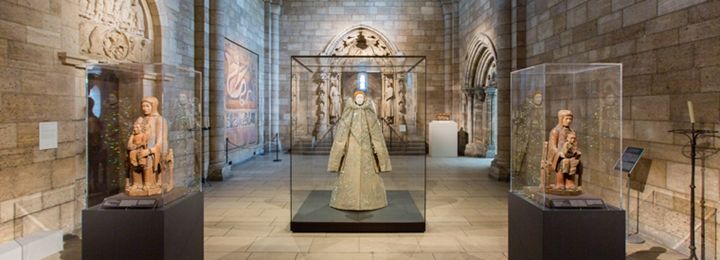
The emphatic silhouette and extravagant decoration of this dress by Viktor & Rolf recall the popular Marian devotion of dressing sculptures of the Madonna and Child. The practice dates to the early Middle Ages and took root in the later part of the period, when the cult of the Virgin Mary was rapidly developing in Western Europe. Wood statues like the two adjacent Romanesque masterworks exemplifying the Throne of Wisdom type, with the Virgin holding the Child in her lap, were at times carried in processions and adorned with costumes and votive offerings.
Viktor & Rolf 's dress, with strings of crystal rosaries wrapped around the wrists, directly references this practice. It was featured in their Russian Doll collection, which was staged as a performance during which the designers dressed the model Maggie Rizer in successive layers of clothing, transforming her into a matryoshka (nesting) doll in reverse. After the performance, Viktor Horsting and Rolf Snoeren equated the care and devotion they lavished upon Rizer as a form of icon worship.
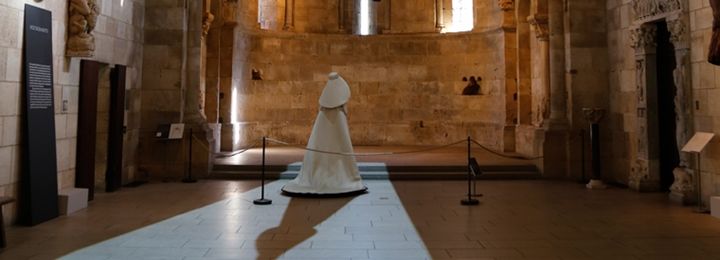
The Fuentidueña Chapel features characteristics typical of Romanesque architecture, such as thick walls, small windows, and rounded arches. It also includes liturgical furniture universal to medieval churches. These furnishings and the sacraments associated with them provide the context for the fashions displayed here. A capital adapted as a font for holy water is adjacent to garments inspired by baptism—the sacrament of rebirth expressed by washing or marking with water—including designs by Azzedine Alaïa and A.F. Vandevorst.
The apse, decorated with a fresco depicting the Virgin and Child in Majesty, provides the framework for the two wedding dresses. The form of the example by Cristóbal Balenciaga recalls the inflated, cone-like gowns worn by figures of the Virgin carried in church processions, such as the two medieval statues in the Romanesque Hall. The garment by Karl Lagerfeld for Chanel is derived from a style of dress worn by girls in France for their First Holy Communion.
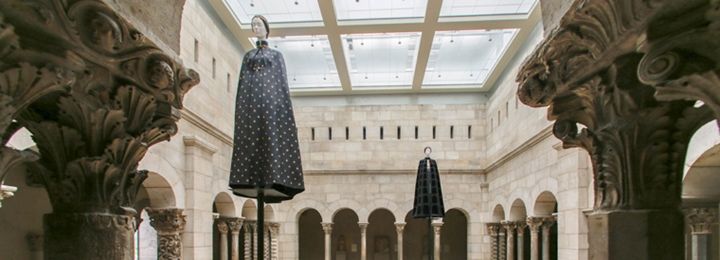
The Met Cloisters evokes a sense of medieval monastic life through its architecture. The Romanesque style prevails in the Saint-Guilhem Cloister, which was part of a Benedictine monastery in the village of Saint-Guilhem-le-Desért, located in a region of France with abundant ruins of Roman monuments. The two ensembles featured here echo these classical influences. Designed by Maria Grazia Chiuri and Pierpaolo Piccioli, they formed part of Valentino's autumn/winter 2015–16 haute couture collection, which was an homage to Rome, where the house was founded. The arches of the Colosseum served as the reference for the ensemble composed of a dress and cape. They appear as black silk velvet pieced into double-faced cashmere, creating a tour de force of the techniques of haute couture. In its arched splendor, the cape establishes a formal connection with the rounded arches of the Saint-Guilhem Cloister.
The other ensemble was inspired by the Black Madonna of Częstochowa, an oil painting on wood depicting the Madonna in a black cape adorned with stars. It establishes a more conceptual relationship with the space through its color: the Benedictine monks who originally occupied the monastery and who became known as the "Black Monks" because of their black habits.
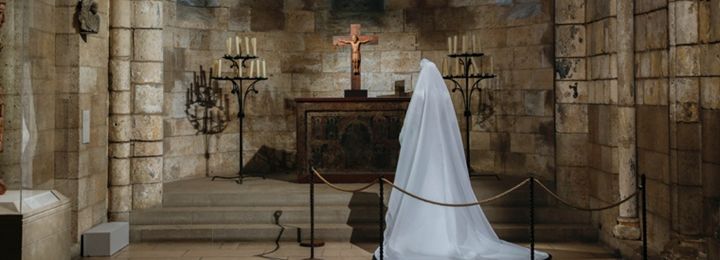
The plan of the Langon Chapel, like that of the nearby Fuentidueña Chapel, consists of a simple, single-aisle nave and a semicircular apse. As in all medieval churches, the altar is the focal point. Unquestionably the most important piece of liturgical furnishing within a church, the altar is where Mass is celebrated, including the Mass for the sacrament of Matrimony—a rite that is recognized in the wedding dress on view here. The finale to Marc Bohan's debut collection as head designer of the House of Dior, it is titled Hyménée after Hymen, the Hellenistic god of marriage. However, the holy sacrament of marriage is just one of many religious associations evoked by its design. The ascetic minimalism of the ensemble, with a single camellia as its sole decoration, and the veil with its wimple-like front bib prompt comparisons to a monk's or nun's habit. In both the runway presentation and a later magazine editorial photographed by Guy Bourdin, the model posed with a rosary in her hands.
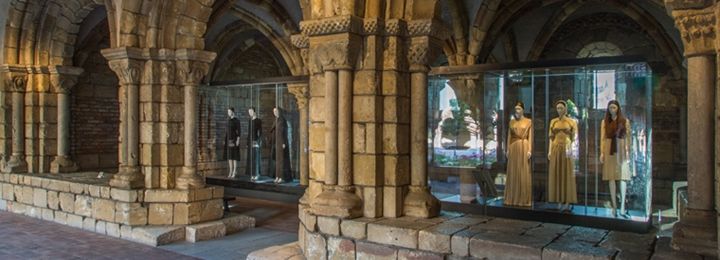
The nucleus of daily monastic life, the cloister is usually located at the heart of a monastery or convent, next to the church. The location of the Cuxa Cloister adjacent to the Pontaut Chapter House here is typical of a medieval monastic plan. In the chapter house, monks or nuns sat on the stone benches around the perimeter every day as business was discussed and a chapter of the Rule of Saint Benedict, the official code of monastic behavior, was read. The fashions featured in these two spaces are by designers who are known for their monastic silhouettes and minimalist sensibilities, including Geoffrey Beene, Madame Grès, Claire McCardell, Rick Owens, Pierpaolo Piccioli, and Valentina. These designers largely keep to the simplicity and modesty of monastic clothing in their fashions, confining themselves to a monochromatic palette—principally black, white, and a spectrum of browns. Deceptively simple, their pared-down, body-obscuring fashions claim further alliances to monastic dress through the layering of flowing columns of fabric.
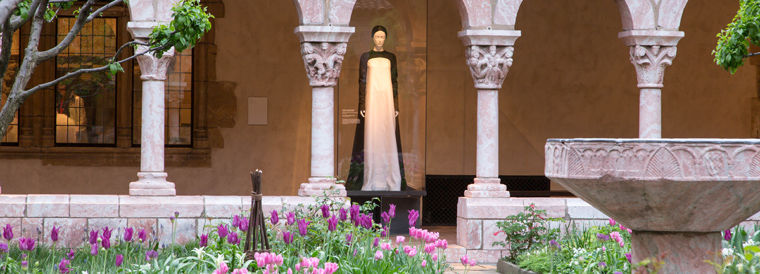
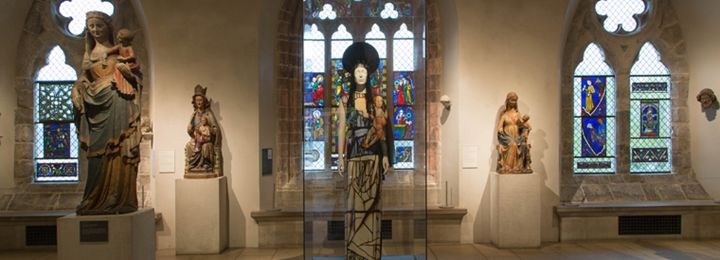
Some of the most remarkable examples of medieval stained glass in The Met Cloisters are found in the Early Gothic Hall. In medieval thought, the physical property of glass that allows it to transmit light while remaining intact was likened to Mary giving birth to Jesus while remaining a virgin. This idea is reflected in a dress by Jean Paul Gaultier on view here. Aptly titled Lumière, it is printed with an image of fifteenth-century French court painter Jean Fouquet's Virgin and Child Surrounded by Angels (the right panel of the Melun Diptych, ca. 1452), which Gaultier renders in leaded stained glass, fragmenting the image almost beyond recognition.
This dress and the other two on view belong to his spring/summer 2007 haute couture collection titled les Vierges (the Virgins). The collection represented a sartorial meditation on the Blessed Virgin Mary, the subject of many of the sculptures in the Early Gothic Hall. It effectively unfolded as a catalogue of Marian iconography, including the halo, the veil, the color blue, and the Immaculate Heart of Mary. Traditionally, the heart, almost invariably shown with a pierced sword, symbolizes the Virgin Mary as a grieving mother, and is one of the most popular Marian devotions.
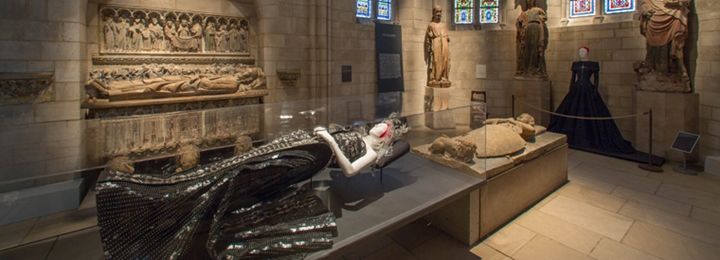
The Gothic Chapel is perhaps most noteworthy for its seven tombs with commemorative sculptural effigies, including the counts of Urgell, a knight of the d'Alluye family, and a lady (probably Margaret of Gloucester, the wife of Robert II, baron of Neubourg). These superb examples of sepulchral art are in conversation with the fashions on display. In its armored magnificence, John Galliano's ensemble establishes both a formal and a conceptual relationship to the armored gisant (recumbent effigy) of the knight of the d'Alluye family from the Abbey of La Clarté-Dieu.
For three generations, men of the d'Alluye family of France "took the cross" and embarked for the Holy Land to "reclaim" it for European Christians (and, in the process, redeem their own souls). The dresses by Gareth Pugh and Olivier Theyskens echo this familial narrative through the crosses emblazoned across their bodices. In both ensembles the crosses are functional as well as decorative, as they are composed of fasteners: zippers in the dress by Pugh and hook-and-eye closures in the dress by Theyskens.
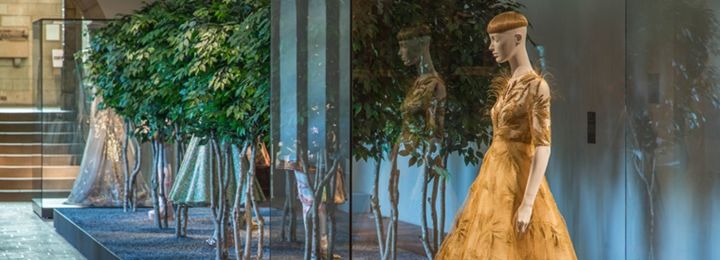
The three gardens at The Met Cloisters (Cuxa, Bonnefont, and Trie)—all designed and planted based on medieval texts and images—inspired the selection of garments in the Glass Gallery. The dress by Maria Grazia Chiuri and Pierpaolo Piccioli for Valentino was directly influenced by German painter Lucas Cranach the Elder's depiction of the Garden of Eden in Adam and Eve (1526). Given its status in the Bible and its role in Christian historiography, it is not surprising that the Garden of Eden is a popular subject among artists and designers. Hieronymous Bosch's triptych The Garden of Earthly Delights (ca. 1490–1500) inspired Jun Takahashi's spring/summer 2015 collection for Undercover and Raf Simons's autumn/winter 2015–16 haute couture collection for Christian Dior, examples from which, are featured in this gallery.
Bosch's triptych derives its name from its central panel, which depicts Eden as a false Paradise. Featuring plants and fruits both real and fantastical, it is a garden designed to deceive the senses—the antithesis of the three gardens at The Met Cloisters, which follow medieval designs meant to promote a closer communion with God through meditation and contemplation of the beauty of creation.
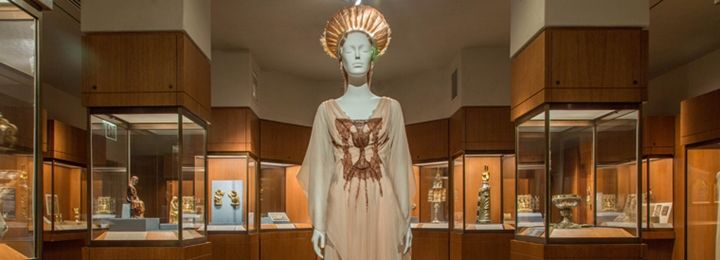
Notwithstanding the biblical injunction to "lay up for yourselves treasures in heaven" rather than on earth (Matthew 6:20), medieval churches continued the ancient tradition of housing their most valuable objects in treasuries. The Met Cloisters treasury, like a similar treasury at the Met Fifth Avenue, contains key examples of such riches from across Europe, from the ninth to the fifteenth century.
These works of art in precious materials are paired with fashions and accessories, some of which share formal associations, and which are treasures in and of themselves. Carved wood panels, illuminated manuscripts, silver and gold reliquaries, liturgical vestments, and ceremonial vessels offer material manifestations of faith that have been reinterpreted by designers in the vernacular of fashion. The objects attest to the artistic sophistication of medieval artists and patrons alike, and the juxtapositions here demonstrate the timeless ability of these works to engage and inspire designers in the present.
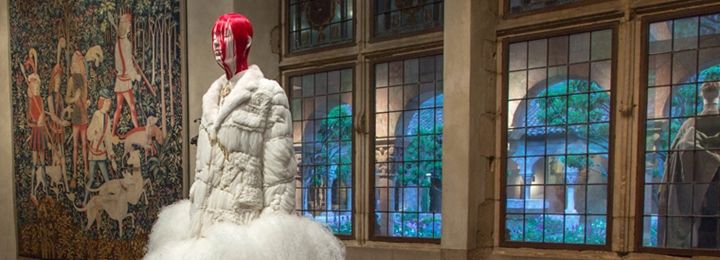
The dramatic narratives and rich botanical details of the Unicorn Tapestries have prompted sacred as well as secular interpretations. This is true, especially, of The Unicorn in Captivity, the most beloved tapestry at The Met Cloisters. Sacred readings of this hanging construe the unicorn as a symbol of Christ, while secular readings interpret him as a happy groom bonded by marriage. These analyses come together in Thom Browne's dazzling wedding dress, which was accompanied down the runway by a life-size unicorn puppet.
Composed of hundreds of white tulle ribbons, the dress has a unicorn camouflaged across its surface, its outline barely visible in gold thread. The back vents are bordered by red ribbons, a poignant allusion to the red drops on the animal's back in the tapestry, often interpreted as the juice of the pomegranate. In a secular reading of the fruit as a symbol of fertility, these red ribbons can suggest menstrual blood. But with a sacred understanding of the pomegranate as a symbol of the Resurrection, they can be interpreted as Christ's blood. Browne's wedding dress, like the tapestry, serves as a poetic reminder that, for the medieval mind, the secular and the sacred were deeply intertwined and nothing was ever far from God.
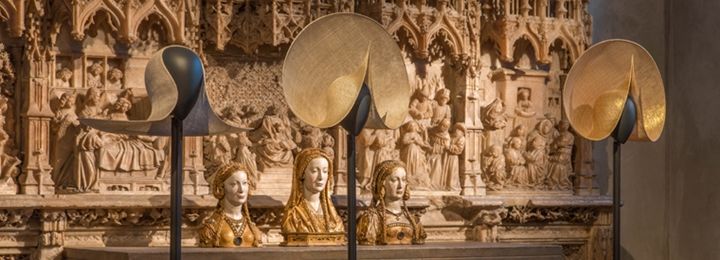
The Boppard Room takes its name from the six large stained-glass windows from the former Carmelite church at Boppard-am-Rhein, near Koblenz, Germany. Dating to 1440–46, the windows feature the Virgin Mary and five saints: Servatius, Lambert, Catherine, Dorothy, and Barbara. The Virgin is dressed in a blue gown adorned with representations of wheat. Known as the Ährenkleid, this iconographic type originated in litanies to the Virgin that likened her to a field of grain nourishing humankind with the bread of life.
The gown introduces the dress embroidered with wheat by Gabrielle "Coco" Chanel, which anchors the room. The wheat on the Chanel dress, as on Mary's garment, signifies God's bounty and the metaphorical harvest reaped from sowing the Gospel. Ears of the grain also represent the body of Christ and the bread eaten during the sacrament of Holy Communion in commemoration of the Last Supper.
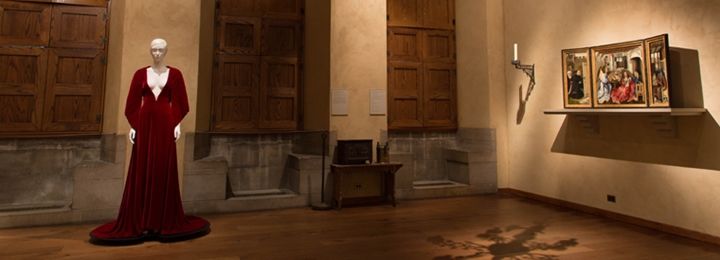
The Merode Room is dedicated to works of art created for private devotion. Its centerpiece is the Annunciation Triptych (also known as the Merode Altarpiece, after its previous owner) by the workshop of Robert Campin. One of the most celebrated works of art at The Met Cloisters, the triptych's attention to detail is emblematic of early Netherlandish painting. The design of the dress by Maria Grazia Chiuri and Pierpaolo Piccioli for Valentino synthesizes the main attributes of the triptych's principal protagonists: the red, flowing robe of the Virgin and the wings of the angel, rendered as voluminous cape sleeves subtly decorated with feathers executed in trapunto quilting. The primary inspiration of the dress was another masterpiece of early Netherlandish painting: Hans Memling's Virgin and Child Enthroned with Two Angels (1485–90; private collection).
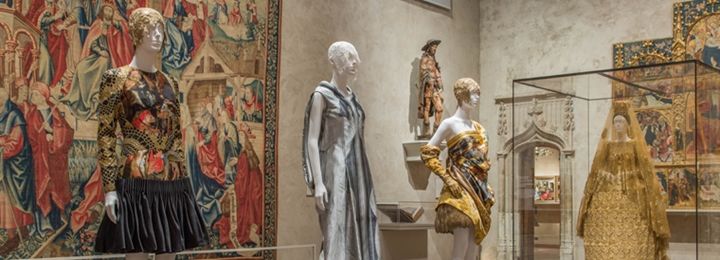
The Late Gothic Hall is the largest gallery at The Met Cloisters, housing paintings and sculpture from the late fifteenth and early sixteenth centuries, most of which came from dismantled large altarpieces of Germany and Spain. These altarpieces contextualize the fashions featured in the hall, several of which were designed by Alexander McQueen. Religion was an unflagging source of inspiration for the designer, especially early Netherlandish religious paintings. Asked if he could live and work in any era, McQueen responded: "Fifteenth-century Flanders. My favorite part of art. Because of the colors, because of the sympathetic way they approached life."
The influence of early Netherlandish painting is explicit in the ensembles McQueen designed for his autumn/winter 2010–11 collection, shown following his death on February 11, 2010. The collection was inspired by religious paintings and altarpieces by artists such as Hieronymus Bosch, Botticelli, Jean Fouquet, Hugo van der Goes, Jean Hey, Stefan Lochner, and Hans Memling. The designs poignantly represented McQueen's lifelong engagement with the themes of religion and the afterlife.
John Galliano (British, born Gibraltar, 1960) for House of Dior (French, founded 1947). Evening ensemble, autumn/winter 2000–2001 haute couture. Courtesy of Dior Heritage Collection, Paris. Digital composite scan by Katerina Jebb